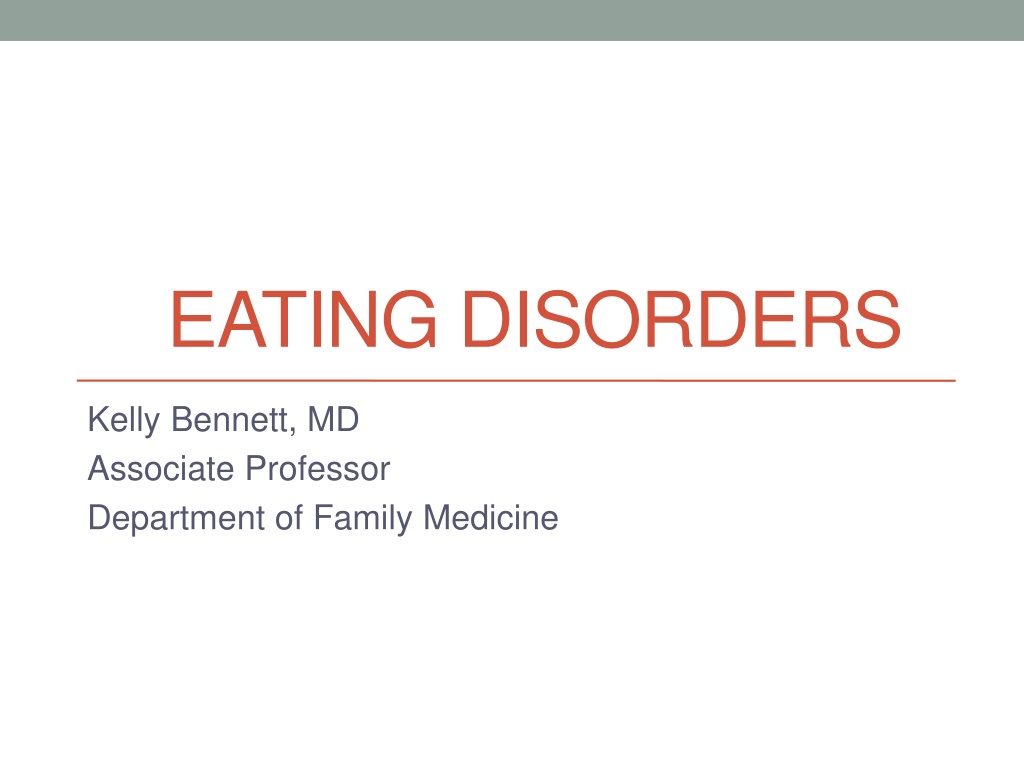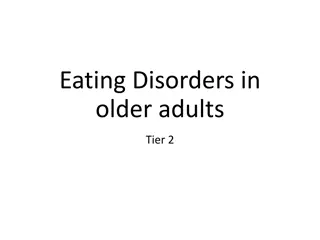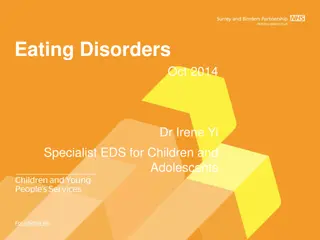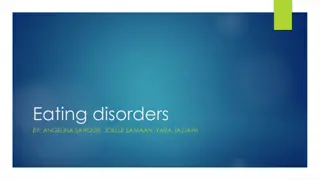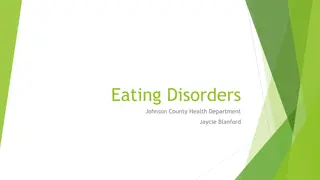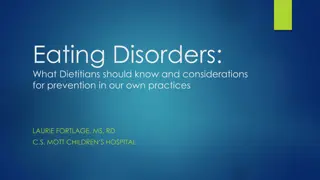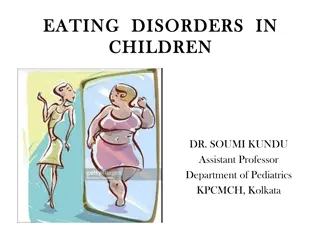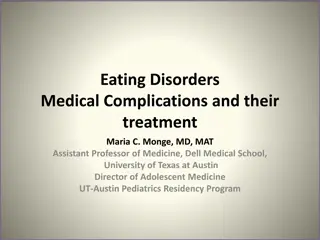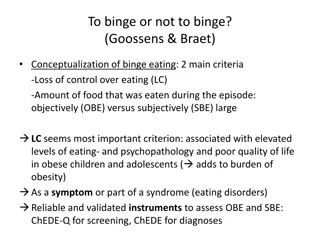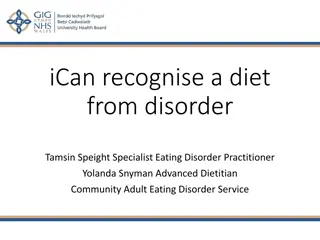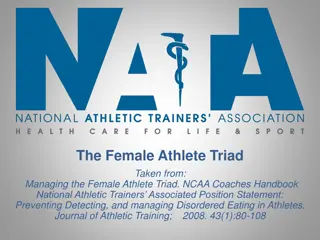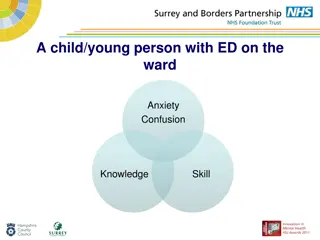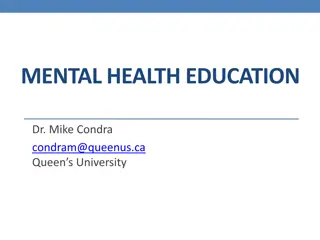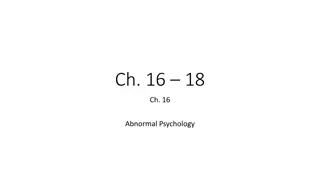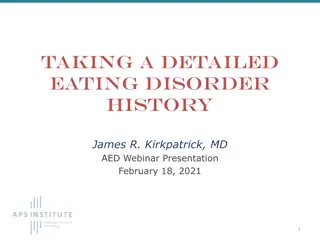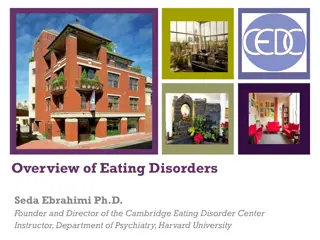Understanding Eating Disorders: Diagnostic Criteria, Signs, and Treatments
This presentation covers the diagnostic criteria, signs, and treatments for anorexia nervosa, bulimia nervosa, and binge-eating disorder. It details the subtypes, severity levels, prevalence, development, courses, and risk factors associated with eating disorders, providing a comprehensive overview for healthcare professionals.
Download Presentation

Please find below an Image/Link to download the presentation.
The content on the website is provided AS IS for your information and personal use only. It may not be sold, licensed, or shared on other websites without obtaining consent from the author. Download presentation by click this link. If you encounter any issues during the download, it is possible that the publisher has removed the file from their server.
E N D
Presentation Transcript
EATING DISORDERS Kelly Bennett, MD Associate Professor Department of Family Medicine
Objectives Describe the diagnostic criteria for anorexia, bulimia, and binge eating disorders Describe the signs and symptoms for anorexia and bulimia Describe the objective findings for anorexia and bulimia Describe the treatments for anorexia and bulimia Be able to discuss the teamwork approach in the treatment of eating disorders
DSM 5 Classification Anorexia Nervosa Restrictive type Binge Eating/Purging type Bulimia Nervosa Binge-Eating Disorder
Anorexia Nervosa Diagnostic Criteria Restriction of caloric intake relative to requirement leading to significantly low body weight Intense fear of gaining weight Disturbance in the way in which one s body weight or shape is experienced
Subtypes Restrictive Weight loss is accomplished through dieting, fasting, and/or excessive exercise Binge eating/purging Also engaging in binge eating or purging behavior (vomiting, , misuse of laxative, diuretics or enemas) Specify if in partial or full remission
Severity of Anorexia Based on World Health Organization categories for malnutrition Mild: BMI > 17 Moderate: BMI 16-16.99 Severe: BMI 15-15.99 Extreme: BMI < 15
Prevalence of Anorexia 12 month prevalence in young women 0.4% 10:1 Female to Male ratio
Development and Course Begins during adolescence or young adulthood Generally will go into remission within five years If severe enough to be hospitalized (medical facility) remission rate lower Mortality rate is 5% per decade (from medical complications or suicide)
Risk Factors Higher rate of development in people with anxiety disorders or obsessive compulsive disorders Environments of extreme fitness or thinness Athletics, modeling, acting, dancing Genetic: increased risk among first degree relatives; concordance rates in monozygotic twins is very high
Case 1 22 white female presents with fatigue and shin pain HPI: patient has felt tired for several months; exercises two to three hours daily on treadmill; admits to excessive calorie counting Physical Exam: Thin in appearance; can see strap muscles on neck Heart bradycardic; lungs clear Abdomen: cachectic; normal bowel sounds Extremities: muscle wasting Labs: H/H: 5/15 CMP: elevated LFTs, low calcium X-rays: tibias fractured bilaterally
Case 1 continued BMI: 14 Admitted patient to the hospital Troponin 5 x normal ECHO: hypo kinesis; cardiology consulted Bone scan: osteopenia; started on Fosamax and calcium Placed by orthopedics in bilateral walking boats Patient started on TPN; was in house for two weeks Transferred to In patient treatment center
Symptoms Amenorrhea Depression Pain in extremities Cold intolerance Constipation Insomnia Pre-syncope and Syncopal episodes
Physical signs Emaciation Hypotension Hypothermia Bradycardia Lanugo Sallow color of skin Osteopenia
Objective Findings Hematology: leukopenia, anemia Chemistry: elevated triglycerides, elevated low density lipid (LDL), elevated Liver function tests, low magnesium, low phosphate Endocrine: low T4 and T3; females with low estrogen, males with low testosterone EKG: bradycardia, prolongation of the QT interval Bone mass: low bone mineral density
Differential Diagnosis Hyperthyroidism Occult malignancy HIV/AIDS Gastro Intestinal disorder Substance use (meth, stimulants)
Psychological Characteristics Refusal to eat despite feeling hungry Body dysmorphia (believing fat while emaciated) Lack of sex drive Interfamily conflicts Excessive exercising Generally was/is a good student (honors, AP)
Treatment Team approach: Primary care doctor Nutritionist/Dietician Therapist +/- psychiatrist CAUTION with group therapies Intensive outpatient behavioral/psychological treatment In patient behavioral/psychological treatment programs In patient medical hospitalization Family therapy
Hospital Treatment Medical hospitalization sometimes required for those with severe malnutrition and always with extreme malnutrition (generally less than BMI of 16) Re-feeding syndrome Too much food into the non active gut can cause massive electrolyte shifts resulting in high magnesium and phosphate levels This can lead to fatal arrhythmias Discovered after World War II when concentration camp victims were fed too quickly by allied personnel Must use TPN first (total parental nutrition) before starting oral feeds
Bulimia Nervosa Recurrent episodes of binge eating Within a discrete time period an amount larger than the average individual would eat Sense of lack of control Recurrent inappropriate compensatory behaviors Self induced vomiting Misuse of laxatives, diuretics, enemas Fasting or excessive exercise This behavior is noted at least once weekly for three months Body weight is not influenced (can be normal or overweight)
Bulimia Can be in partial or full remission Severity: Mild: 1-3 episodes per week Moderate: 4-7 Severe: 8-13 Extreme: > 14
Associated features Eating in private Feeling shameful about eating Hiding purging (hiding vomiting or meds for diuresis or laxatives) Most patients with BMI 18-30 12 month prevalence is 1-1.5% 10:1 Female to male ratio
Risk factors Low self esteem, social anxiety, dysthymia Environments of thin culture Genetic: childhood obesity and early puberty increase the risk; familial transmission not as strong as anorexia
Case 2 18 Hispanic female presents due to excessive heartburn HPI: patient admits to binging and purging; vomits four to five times daily; exercises to extreme; admits to depression Physical: Patient with enlarged parotids, scars on back of hands; dental enamel deteriotion; otherwise physical is normal Labs: EKG, CBC, CMP, TSH all normal Diagnosis: GERD due to frequent emesis Treated with antidepressants, counseling, nutritionist Ended up having to have partial parotidectomy and dentures
Symptoms Parotid gland pain Gastro esophageal reflux Constipation Menstrual irregularities
Signs/lab work Many times no abnormalities are noted on physical exam or lab testing Parotid enlargement Poor dentition Scarring on hands (Russell sign) Electrolyte abnormalities Melanosis coli (blackened colon walls noted on colonoscopy if misusing laxatives)
Treatment Team approach Primary care physician Nutritionist/Dietician Therapist +/- psychiatrist Antidepressants {usually SSRIs; bupropion (Wellbutrin) contraindicated due to lowered seizure threshold} Again caution with Group therapy; must be supervised Intensive outpatient or inpatient behavioral/psychological treatment Rarely needs medical hospitalization
Binge-Eating Disorder Recurrent episodes of binge eating Eating in a period of time an amount above what an average person would eat Sense of lack of control Associated with 3 or the following 5: Eat more rapidly than normal Eat until feeling uncomfortably full (sick) Eating when not hungry Eating while alone due to embarrassment Feeling disgusted after eating There is NO COMPENSATORY behavior of restricting calories through fasting, purging, exercise
Binge Eating Partial versus full remission Severity Mild: 1-3 episodes of binge eating in one week Moderate: 4-7 Severe: 8-13 Extreme: >14 Ratio Female to Male closer to the same
Binge-Eating Patients generally >18 BMI Generally there are no signs or symptoms Treatment Primary Care Physician Nutritionist/Dietician Therapist
Bibliography Diagnostic and Statistical Manual of Mental Disorders. Fifth Edition; pages 338-353. First Aid for the Basic Sciences: Organ Systems. Second Edition; pages 567-572. Board Review Series: Behavioral Science. Sixth Edition; pages 148-149.
